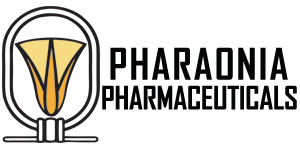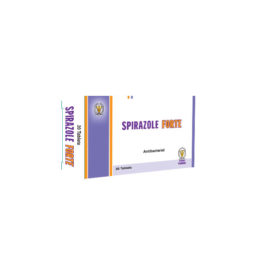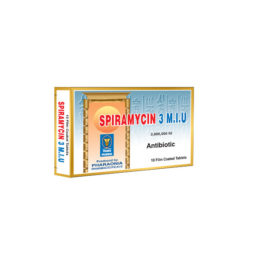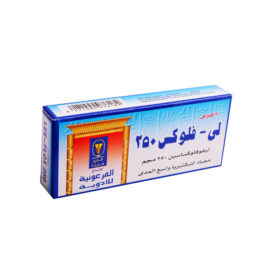Description
Ornidazole is a 5-nitroimidazole derivative with activity against anaerobic Bacteria such as, Bacteroides and Clostridium spp., Fusobacterium and anaerobic cocci, and Protozoa such as, Trichomonas vaginalis, Entamoeba histolytica and Giardia lamblia (Giardia intestinalis)
Pharmacokinetics:
Absorption:
Ornidazole is readily absorbed from the gastrointestinal tract (Mean absorption of 90%), and peak plasma concentrations are reached within 3 hrs.
Distribution:
After repeated oral doses of 500 mg every 12 hrs., steady-state peak and trough concentrations are 14 and 6 micrograms/ml respectively.
The active ingredient penetrates the cerebrospinal fluid, the body fluids and the tissues very effectively. Less than 15 % is bound to plasma proteins.
Elimination:
The plasma elimination half-life of ornidazole is 12 to 14 hrs. Biliary excretion may be important in the elimination of ornidazole and its metabolites. 85% of a single dose is eliminated within the first five days. Ornidazole is metabolised in the liver and is excreted in the urine (63%), mainly as conjugates and metabolites, and to a lesser extent in the faeces (22%). About 4% of the dose is excreted as unaltered substances through the kidneys.
- Hepatic impairment: the interval between doses of ornidazole should be doubled in patients with marked hepatic impairment. Dose adjustment is needed in patients with other forms of liver disease.
- Renal impairment: modification of the usual dosage is not necessary.
Optimal plasma concentrations: Depending on the indication and the dosage schedule, the optimal plasma concentrations of the active ingredient are between 6 and 36 μg per ml.
Indications:
- Trichomoniasis, Genitourinary infections in women and men due to Trichomonas vaginalis.
- Amoebiasis, all intestinal infections due to Entamoebae histolytica, including amoebic dysentery. All extra-intestinal forms of Amoebiasis, especially amoebic liver abscess.
- Giardiasis (lambliasis).
Dosage and administration:
Always to be taken after meals.
- Trichomoniasis, possible therapeutic regimens:
-Single-dose therapy
-Five-days therapy.
| Type of treatment | Daily doses (500 mg tablets) | |
| Single-dose therapy | Alternative 1 | Alternative 2 |
| 3 tablets in the evening. | 2 tablets + one vaginal suppository before going to bed*. | |
| Five-days therapy | 1 tablet in the mornings and the evenings. | 1 tablet in the mornings and the evenings + one vaginal suppository before going to bed*. |
* Tibezole is also available in the form of vaginal suppositories.
In all cases the sexual partner should also be treated using the same oral dosage (alternative 1) so as to avoid re-infection. The dosage for children is 25 mg per Kg body weight per day and given in a single dose.
- Amoebiasis: possible therapeutic regimens:
Three-days treatment of patients with amoebic dysentery and five-to-ten days treatment (all form of Amoebiasis).
| Duration of treatment | Daily doses | |
| Adults and children over 35 Kg (500mg tablets) | Children up to 35 Kg ( 125 mg tablets) | |
| Three days | *3 tablets in one evening dose
*over 40 Kg body weight: 4 tablets (2 tablets in the morning and in the evening). |
* one tablet per 3 Kg body weight in one dose ( equivalent to 40 mg per Kg) |
| Five to ten days | 2 tablets ( one tablet in the morning and one in the evening) | One tablet per 5 Kg body weight in one dose ( equivalent to 25 mg/Kg) |
- Giardiasis (lambliasis)
| Duration of treatment | Daily doses | |
| Adults and children over 35 Kg (500mg tablets) | Children up to 35 Kg ( 125 mg tablets) | |
| One to two days | 3 tablets in the evening in one dose | One tablet per 3 Kg body weight in one dose ( equivalent to 40 mg per Kg) |
Contraindications:
It is contraindicated in patient with disease of the CNS or known hypersensitivity to the drug or any other nitroimidazole derivatives.
Ornidazole should not be prescribed in early pregnancy except when absolutely necessary.
Side effects:
Ornidazole is generally well tolerated. Mild side effects such as dizziness, somnolence, headache and gastrointestinal disturbances like nausea and vomiting may occur.
Drug interactions:
-In contrast to other nitroimidazole derivatives ornidazole does not inhibit aldehyde dehydrogenase and is therefore not incompatible with alcohol. However, ornidazole potentiates the effect of coumarin-type oral anticoagulants. The dosage of the anticoagulant has to be adjusted accordingly.
-Ornidazole prolongs the muscle relaxant effect of vecuronium bromide.
Precautions and warnings:
- Peripheral neuropathy, transient epileptiform seizures and leucopenia have sometimes been associated with prolonged or intensive treatment with ornidazole.
- Clinical and laboratory monitoring is advised in patients receiving ornidazole for more than 10 days.
- Doses should be reduced in patients with severe hepatic impairment.
- Patients are advised not to drink alcoholic beverages while taking ornidazole.
Pregnancy and lactation:
-It is suggested that the use of ornidazole should be avoided during pregnancy, and this caution applies especially to use during the first trimester and to the use of high dose regimens.
-Ornidazole is mutagenic in bacteria and carcinogenic in rodents. It readily crosses the placenta achieving similar concentrations in the placental cord and maternal plasma and its use in pregnancy is controversial. Meta-analyses of studies involving the use of ornidazole in the first trimester of pregnancy concluded there did not appear to be an increased risk of teratogenicity. However it is contraindicated during the first trimester in patients with Trichomoniasis, use for Trichomoniasis during the second and the third trimester may be acceptable.
-For other indications the risks and benefits of treatment with ornidazole should be weighed carefully, especially in the first trimester.
-Ornidazole is distributed into breast milk giving it a bitter taste which may impair feeding.
-Breast feeding should be discontinued for 12 to 24 hours when single dose therapy is used.
Packaging:
Tibezole 500 tablets: A carton box containing 3 tablets or 10 tablets in PVC/ Al strip and an inner leaflet.
Tibezole 125 tablets: A carton box containing 10 tablets in PVC/Al strip and an inner leaflet
Storage:
Keep at temperature not exceeding 30°C, in dry place.
Keep out of reach of children.
Instructions to patients:
- Avoid alcoholic beverages.
- Always to be taken after meals.
- Avoid activities which require you to be alert such as driving and operating machinery, since ornidazole may cause dizziness.








Reviews
There are no reviews yet.